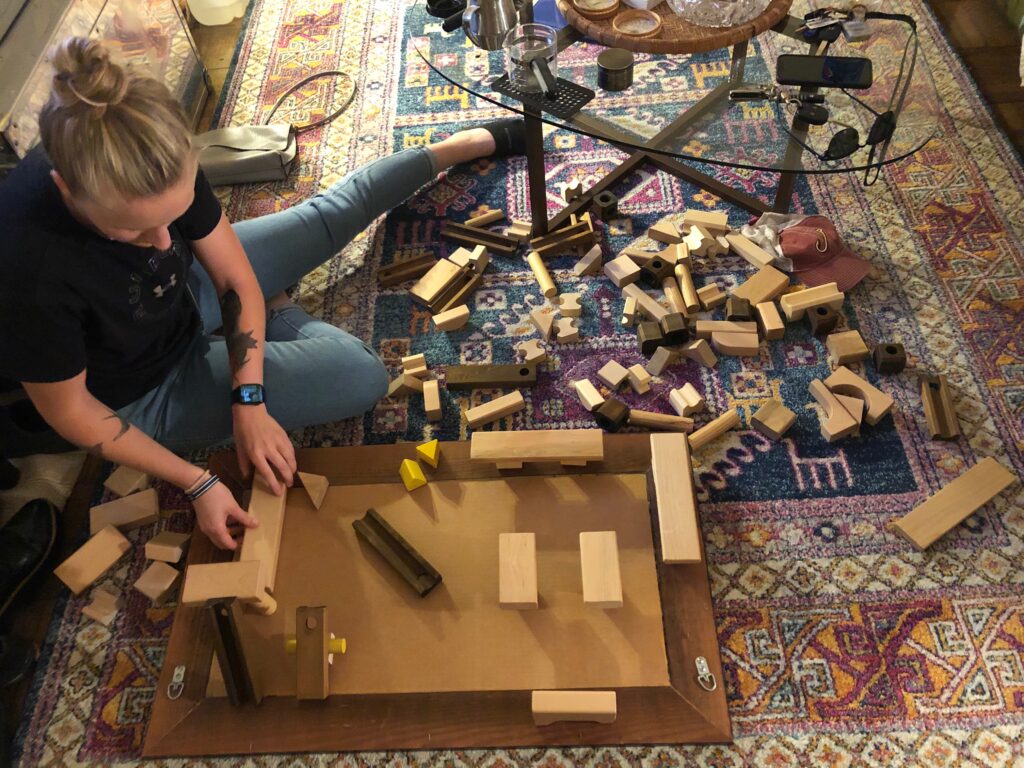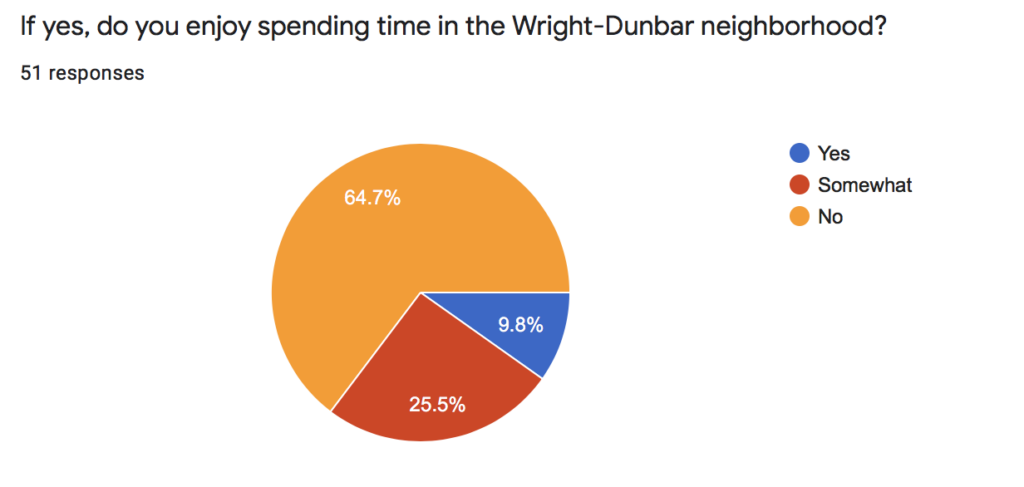Productivity can be defined by how efficient you are when doing work. So, what happens when elements outside of your control distract you from your goals? Current trends in working from home and working hybrid have changed the world for working professionals. When it comes to completing daily tasks, your work environment plays a significant role. Current trends include co-working spaces that have popped up all over the world, especially in larger cities. Through the success and failures of these startups, we can evaluate what is working for remote working professionals and students, and what needs revision. The exploration of co-working is relevant to the opportunity presented as my senior thesis project. The project is centered around revitalizing an urban space in the historic Wright-Dunbar neighborhood centrality of Dayton, OH. Inviting community members into the business district in a post-pandemic world will be explored through extensive research and thoughtful design implementations.
The historic site in Dayton, OH, will be revitalized as a communal space for creativity and productivity to flourish. The site address is 1127 W 3rd St and is the former home of the original Wright Brothers cycling shop. The open, grassy plot is now empty and undergoing reimagination for an outdoor co-working space for members of the community. The project seeks to provide the community with a space for focus and collaboration, amid new developments in the diverse landscape. Among the various developments coming to the Wright-Dunbar neighborhood centrality are market-rate apartments and an up-and-coming food hall. Also nearby is the National Aviation Heritage Area, which employs the individuals who presented us with the design opportunity. This project proposal came as a result of the disclosed needs of the Rediscover Dayton Action Plan, a plan designed by volunteers and community members.
The objective is to create a space that invites the existing community members from all socioeconomic landscapes to gather in a space, reminiscent of the Wright Brothers. The intention is to support productivity and connection in an outdoor setting. The design of the space will aim to provide an alternative work environment, other than home or office, for locals to gather and work. The general goals of this design will be to support productivity, concentration, and encouragement of community engagement with one another. Various factors of the site include a busy street front location and small local businesses nearby. Additionally, the area is known for its diversity and historical background.
Many community members are familiar with the cultural landscape, and value upholding the region’s rich history. As the area undergoes development, serving the needs of the current residents is vital in evading the negative impacts of gentrification and preserving the local diversity. Design research and development will emphasize uplifting the community through thoughtful adaptations for outdoor usage in an urban setting. To avoid negative impacts on community members, the space must align with local building conventions to promote utilization from individuals already in the area. A sense of familiarity contributes to the local identity, in an effort to pay tribute to what has already been established. The project will explore three main proponents to improving the experience of being in an outdoor, communal workspace that includes: Protection from the elements, sound management, and spatial design.
Stakeholders for this development opportunity include the professionals of Dayton, OH, including freelancers, downtown office workers, their clients, and those who work remotely or hybrid. Another group of stakeholders includes the local business owners, including the surrounding stores and their owners/employees. These individuals play a significant role because these people rely on the economic activity in the immediate area. Residents, individuals who pay taxes and make up the Wright-Dunbar community, are essential in curating a space that will be used by the current locals. A group that plays a pivotal role in bringing this concept to life is the National Aviation Heritage Area (NAHA) members. The individuals who make up the NAHA have professional interests in the success of this senior thesis project and the surrounding community, as well as those who maintain the property. Additional stakeholders include visitors, which can be defined by those who enjoy the history of the Wright Brothers, marking the significance of the location. Dayton students also make up a population of users to be considered for this space, including those commuting from the University of Dayton and Sinclair College. All stakeholders are composed of individuals who want a new creative space to meet and collaborate, or will be directly impacted by its development. Lastly, Dayton creatives, such as freelance artists will be another group of individuals who are stakeholders in this project.
The opportunity is intended to serve the interests of community members and all stakeholders listed previously. Through the exploration of common pain points and desires by individuals working in communal spaces, the identification of sound management and noise privacy stood out as a strong contender for strategic design implementations. This design opportunity will take place in a vacant outdoor location, defined by its strong cultural and historical identity. According to Harvard Business Review, A 2013 study from the University of Sydney found that a lack of sound privacy was far and away from the biggest drain on employee morale. In the same article, a 2014 study by Steelcase and Ipsos found that workers lost as much as 86 minutes per day due to noise distractions.
Activities such as block building were used to create an “ideal” workspace, with no bounds or restraints as to what could be done. The aspects that were mentioned include creating an outdoor, shared space, for getting work done. Different users prioritized different aspects, and through this activity, we were able to identify the need for shelter from the elements, a desire for sectioned areas for privacy, the inclination to gather and collaborate with others, and opportunities for fun and/or playful elements. To better understand how to enhance the space, sound management will be explored to promote productivity, free from distraction.


During the visit to the site, the elements of the urban locality were made evident through traffic noise, as well as pedestrian activity. This brought to my attention ambient noises that will be an unavoidable factor that is built into the surrounding environment the street front location. The aim will be to maintain the outdoor landscape, without enclosing the area to be completely soundproof. The proper balance between seclusion and an open layout is necessary for defining how sound management can best promote productivity.
Material exploration is a large proponent in constructing this space to absorb sounds, to keep outside noises out, and conversations private. The material used will not only inform the aesthetic of the space but will play a crucial role in maintaining a low-maintenance design, intended for longevity. Research surrounding natural and synthetic soundproofing materials provides insight into the upkeep and costs of constructing sound barriers and/or baffles. Biophilic properties and porous materials have extensive qualities making each suitable for sound management in an outdoor space. It’s important to recognize that the space will be utilized all year long and should require little maintenance for the space to be operable. Due to these constraints, material usage will not only need to consider sound waves and ambient noises but how durable they are over time.
The research phase focuses upon various components such as the surrounding community, current studies, coworking strategies, and material usage to develop insights into proper sound management in a space intended to support productivity. Current known factors include the site’s rich history surrounding the innovative spirit of the Wright brothers, which will inform aesthetic decisions, such as materials and art.
Identifying the needs of current community members is important in making a positive and lasting impact on the Wright-Dunbar neighborhood. Additionally, the need for private spaces in combination with collaborative spaces will be explored closely with the spatial design, and factors such as dividers and the materials used for their development will coincide with plans for protection from the elements.
Surveys were utilized to gather information on Dayton community members and their general perceptions of the Wright-Dunbar neighborhood. In conducting this survey, I found that 50.8% of participants said they are familiar with the Wright-Dunbar neighborhood. Of those participants, 64.7% said they do not enjoy spending time in the Wright-Dunbar neighborhood. However, 64.2% of participants said they do not avoid spending time there. The consensus from this survey is that most people are aware of the neighborhood, and of those participants, 96.8% believe downtown Dayton needs improvement, and 85.7% of participants would like to see new development. In understanding the population’s attitude toward development, we can create a space that meets the standards of cultural and historical significance, providing members of the Dayton community with more outlets to engage with their surroundings.



With acoustic regulation being identified during the research phase as a common pain point among working professionals, the direction of this opportunity is heavily impacted by the built-in environment. The overall goal will be to enhance this aspect of the community alongside spatial design and protection from the weather. Ideally, the space will provide an alternative to traditionally used workspaces such as the office, home, or coffee shop by implementing valuable productivity-enhancing elements, in this case, sound management.



